|
|
Sometimes the sound just isn’t there.
Back in the eighties when I was on the board,
and later president, of
SPARS (The Society of Professional Audio
Recording Studios), we would occasionally talk
about consumer audio, which has now evolved into
home theater. There were many anecdotal
observations, an occasional interesting
discovery, and many times things that just
mystified us.
One of the guys was a maintenance engineer for a
large, famous and successful, west coast
studio. On one occasion in a store, while
listening and observing the new and different
items available in home audio, he overheard
someone offering a critique of the low-end bass
on an album. Realizing that his studio had
recorded that artist, he listened more closely
to the nearby conversation, all the while
resolving to not get into the discussion.
Finally, it got to be too much for him and he
said something like this: “I’m sure you are
hearing something there. I’m not disputing that,
and I know it may sound good, but I have to tell
you that my company recorded that album. I’m the
maintenance engineer and I have measured
everything in the recording chain. Our mixing
console cuts-off a full octave above what you
are hearing. It isn’t there!”
Sometimes you can hear what isn’t there.
Back in what I call the “polyester period” or
“disco daze” one of the favorite speakers was
the ALTEC A7 “Voice of the Theater” It looked
huge, especially in 1978, had a big
high-frequency horn and a horn-loaded bass
reflex cabinet. It had to be a great dance music
speaker. Not really!
A clue comes from the trademark phrase “Voice of
the Theater”.
Movie sound was stored on an optical soundtrack,
literally a photograph of the sound modulation.
The range was about 80 Hz to 8 kHz. There was
not much point in adding a tweeter to 20 kHz or
sub-woofers to amplify empty bandwidth. So how
come the movies sounded good? It’s the
engineer’s art.
One of the loudest dance records I ever mixed
was an instrumental of Peter Gunn. As fate would
have it, I was at a music convention in Miami
with the producer when he decided to audition
the mix at a local Disco. As luck would have it,
their speaker of choice was the Altec A-7. When
the needle went down (remember those) the bass
was huge.
How is this possible? I think the word is
psycho-acoustics. Knowing the odds were
good that the record would be played back on a
big but restricted bandwidth system, I cut the
bass off at 80 Hz with an 18 dB per octave
filter. (There's no point in filling bandwidth
that won’t be heard.) To offset this, the range
around 100 – 120 Hz got a big boost. The
listener recognized there was a bass player and
a bass drum and the listener’s ear and brain
created the fundamental frequencies from their
multiples.
Sometimes its there and you hear the
room instead.
So far I’ve talked about equipment and its
effect on the sound. It has been reasonable and
predictable, something to work with, or around.
But what happens in the component that cannot be
predicted or controlled: The other guy’s
listening space. Although most readers will be
interested in the home environment, lessons
learned in the professional world apply there.
At one time in my early career, I recorded big
name acts for radio and television, mostly
before they were big names. It was then that I
found just how bad it could get for me after the
mix left our building.
Hearing that something wasn’t right with the
vocal and orchestra mix, I had recorded for
television, I ventured to the broadcast
production facility for a listen. Sure enough
the mix was thinner than no-fat milk. However,
by chance before I left, I heard the tracks
playing in a different control room within the
same facility. This time the bottom was too
heavy. It was now time to check the room itself.
Low cost analyzers, used to set third octave
equalizer-filters were becoming available by
then, so I took one with me and head back to the
station. Sure enough one room was “River Deep”
and the other was “Mountain High” at the same
frequency by 6 dB. That’s a 12 point spread in
one direction or the other depending upon where
the recording originates and where it plays
back!
It was time for the third octave equalizers to
fix the room. As I have written elsewhere, I was
to find this doesn’t work to fix the listening
space.
It would seem reasonable at first to expect that
a “hole” in the frequency response of a
listening room could be fixed by an electronic
boost at that frequency. Indeed there may be a
sweet spot in the room where that will happen
but it will be a very narrow area.
The reason is this room dimensions. If a wall,
or other boundary surface, is one half
wavelength away from the source of the sound, it
will see its reflection out-of-phase and cancel.
For 40 Hz this is approximately 14 feet. There
will be similar effects on multiples of that
fundamental frequency. A boost with electronics
will also serve to boost the out-of-phase
reflection by and equal amount. It’s a zero-sum
game. The solution is a
bass trap.
The word
bass-trap itself is counter-intuitive. By
trapping the bass, you are preventing it from
reflecting back on itself and canceling. What is
often described as bass build-up in the corners
of a room is really the result of bass absence
in the middle of the room, due to out-of-phase
cancellations.
As a side note, what are often referred to as “corner
bass traps” are really broadband absorbers,
which, although they extend into the low-bass
range, also absorb all of the energy above 250
Hz as well.
A
bass trap needs to be big since the bass
waves are big. One of the most effective traps
is the
polycylindrical diffuser. These are large
curved surfaces, bowed out from the wall at
their center. The center frequency of absorption
is dependent primarily upon the surface size. A
four-foot by ten- foot piece of Masonite®, or
other flexible material, bent to form a “poly”
absorbs everything around 40 Hz. Similarly, four
by eight’s get 63 Hz, two by four’s; 125 Hz and
so forth.
These devices appear as open windows to the
bass. Of course, an alternative is to open the
window but this requires understanding
neighbors, preferably miles away. Long waves
“cycle” far down the road!
If you are old enough to remember Elvis in New
York, you may have seen
polycylindricals on the wall of the RCA
studios where “Hound Dog” was recorded. They are
also still prominent on the movie scoring stage.
Now made of fiberglass and easier to obtain and
install, without hand building, these devices
are making a comeback in
auditoriums and theater applications.
The photos show us building these the hard way
in 1971 and a commercial unit installed on the
wall of a home theater today.
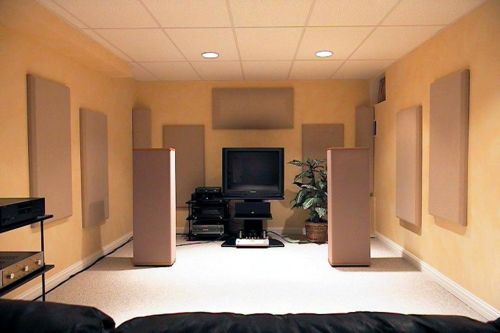
Polycylindrical Diffuser above the screen in
Home Theater.
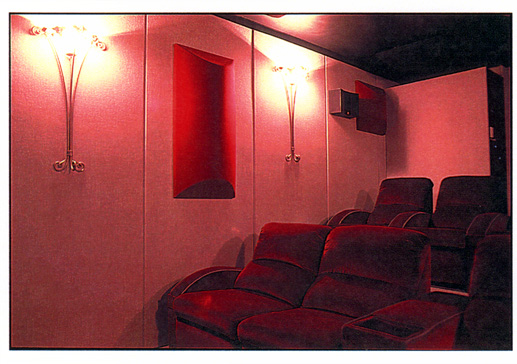
Polycylindrical diffuser in a
home theater.
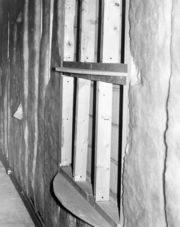 |
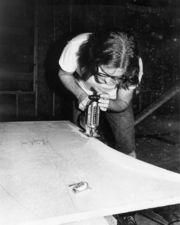 |
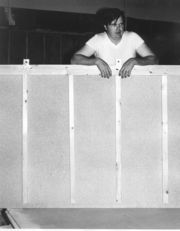 |
Custom unit built into
the wall by the author in 1971.
Alpha Audio Studios photo. |
Engineer (Joe Sheets)
cutting polycylinder forms.
Alpha Audio Studios photo. |
The author
resting on a piece of a
floating floor after
installing polys.
Alpha Audio Studios photo |
|
|
|